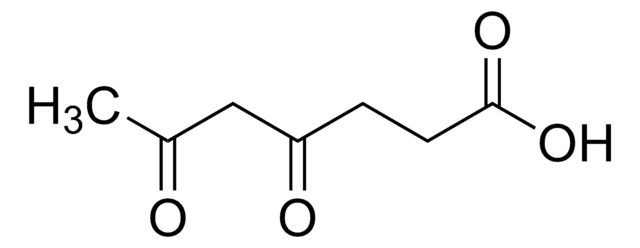W254606
4-Heptanone
≥97%, FG
Synonym(s):
Butyrone, Dipropyl ketone
About This Item
Recommended Products
biological source
synthetic
grade
FG
Fragrance grade
Halal
Agency
follows IFRA guidelines
reg. compliance
EU Regulation 1223/2009
EU Regulation 1334/2008 & 178/2002
FDA 21 CFR 117
FDA 21 CFR 172.515
vapor density
3.93 (vs air)
vapor pressure
5.2 mmHg ( 20 °C)
Assay
≥97%
refractive index
n20/D 1.407 (lit.)
bp
145 °C (lit.)
mp
−33 °C (lit.)
density
0.817 g/mL at 25 °C (lit.)
application(s)
flavors and fragrances
Documentation
see Safety & Documentation for available documents
food allergen
no known allergens
fragrance allergen
no known allergens
Organoleptic
cheese; fruity; pineapple; sweet
SMILES string
CCCC(=O)CCC
InChI
1S/C7H14O/c1-3-5-7(8)6-4-2/h3-6H2,1-2H3
InChI key
HCFAJYNVAYBARA-UHFFFAOYSA-N
Looking for similar products? Visit Product Comparison Guide
Related Categories
Biochem/physiol Actions
Other Notes
Signal Word
Warning
Hazard Statements
Precautionary Statements
Hazard Classifications
Acute Tox. 4 Inhalation - Flam. Liq. 3
Storage Class Code
3 - Flammable liquids
WGK
WGK 2
Flash Point(F)
120.2 °F - closed cup
Flash Point(C)
49 °C - closed cup
Personal Protective Equipment
Regulatory Listings
Regulatory Listings are mainly provided for chemical products. Only limited information can be provided here for non-chemical products. No entry means none of the components are listed. It is the user’s obligation to ensure the safe and legal use of the product.
FSL
Group 4: Flammable liquids
Type 2 petroleums
Hazardous rank III
Water insoluble liquid
ISHL Indicated Name
Substances Subject to be Indicated Names
ISHL Notified Names
Substances Subject to be Notified Names
JAN Code
W254606-12.5KG:
W254606-8KG:4548173970271
W254606-4KG:4548173970264
W254606-1KG:4548173970257
W254606-VAR:
W254606-BULK:
W254606-SAMPLE:
Certificates of Analysis (COA)
Search for Certificates of Analysis (COA) by entering the products Lot/Batch Number. Lot and Batch Numbers can be found on a product’s label following the words ‘Lot’ or ‘Batch’.
Already Own This Product?
Find documentation for the products that you have recently purchased in the Document Library.
Our team of scientists has experience in all areas of research including Life Science, Material Science, Chemical Synthesis, Chromatography, Analytical and many others.
Contact Technical Service









